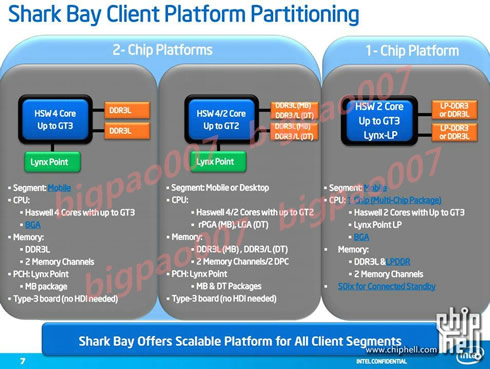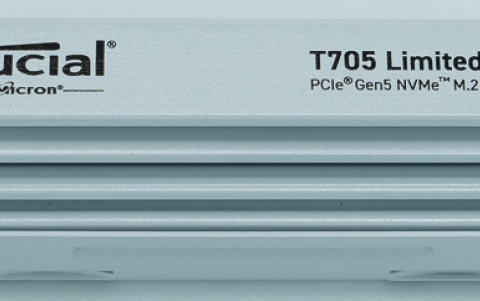
Slides Unveil Details On Upcoming Haswell Chip
With Intel Ivy Bridge coming out next spring, details are emerging on its "Haswell" successor. Intel's next generation x86 architecture will be the first major architectural refresh since Sandy Bridge.
Planned for 2013, products codenamed "Haswell" will be Intel's third step - after the 2nd Generation Intel Core technology with "Ivy Bridge" 22nm chips in 2012 - toward achieving the Ultrabook, Intel's vision of a laptop that combines best-in-class performance, improved responsiveness and security in a thin form factor.
Presentation slides have leaked out revealing much more about the Haswell chip and the "Sharky Bay" platform. The new platform will be found in dekstops, mobile PCs and ultrabooks, powered by "Haswell" dual and quad core chips. Generally, the "Sharky Bay" platform is expected to offer improvements in responsiveness through next generation Intel smart Connect technology; Intel Rapid Start Technology for getting system up and running faster from even the deepest sleep, saving time and battery life; TDP and idle power improvements; and graphics capabilities up to GT3. Ultrabooks based on the platform will offer 5 hours of battery life even in the sleekest form factors with some systems delivering 8 hours or more for all-day usage. In addition, Bios/Firmware will be enabled to expose hardware features for Intel Anti-Theft Technology 4.0 and Intel Identity Protection Technology.
According to the slides, the 22nm Haswell chips will have 1150 pins, meaning that it will require new motherboards. There will be three versions of the chip for desktops, mobiles and ultrabooks.

The desktop versions of Haswell will evidently have four cores that share their last-level cache with the integrated graphics (up to GT2). The CPU supports two channels of DDR3 memory clocked at up to 1600MHz. The slides also show 16 PCI Express 3.0 lanes branching off from the CPU. Other important features include Hyper-Threading, Turbo Boost, Advanced Vector Extensions 2 or AVX 2.0 as well as AES-NI instructions improvements.
According to the slides, desktop versions of Haswell will come with TDP ratings in the 35/45/65/95W range.
Mobile versions with more powerful integrated graphics (up to GT3) will have 37/47/57W TDPs.
A 15W flavor will be also available designed for ultrabooks. This version version of Haswell will be Intel's first system-on-a-chip (SoC) designed for the ultrabook market. SoCs are typically used in smartphone and tablets, due to their compact size. According to the slides, the SoC has dual CPU cores, integrated graphics, and a Lynx Point chipset on a single package.
The slides say products based on the new architecture won't be out until 2013.
Presentation slides have leaked out revealing much more about the Haswell chip and the "Sharky Bay" platform. The new platform will be found in dekstops, mobile PCs and ultrabooks, powered by "Haswell" dual and quad core chips. Generally, the "Sharky Bay" platform is expected to offer improvements in responsiveness through next generation Intel smart Connect technology; Intel Rapid Start Technology for getting system up and running faster from even the deepest sleep, saving time and battery life; TDP and idle power improvements; and graphics capabilities up to GT3. Ultrabooks based on the platform will offer 5 hours of battery life even in the sleekest form factors with some systems delivering 8 hours or more for all-day usage. In addition, Bios/Firmware will be enabled to expose hardware features for Intel Anti-Theft Technology 4.0 and Intel Identity Protection Technology.
According to the slides, the 22nm Haswell chips will have 1150 pins, meaning that it will require new motherboards. There will be three versions of the chip for desktops, mobiles and ultrabooks.

The desktop versions of Haswell will evidently have four cores that share their last-level cache with the integrated graphics (up to GT2). The CPU supports two channels of DDR3 memory clocked at up to 1600MHz. The slides also show 16 PCI Express 3.0 lanes branching off from the CPU. Other important features include Hyper-Threading, Turbo Boost, Advanced Vector Extensions 2 or AVX 2.0 as well as AES-NI instructions improvements.

According to the slides, desktop versions of Haswell will come with TDP ratings in the 35/45/65/95W range.
Mobile versions with more powerful integrated graphics (up to GT3) will have 37/47/57W TDPs.
A 15W flavor will be also available designed for ultrabooks. This version version of Haswell will be Intel's first system-on-a-chip (SoC) designed for the ultrabook market. SoCs are typically used in smartphone and tablets, due to their compact size. According to the slides, the SoC has dual CPU cores, integrated graphics, and a Lynx Point chipset on a single package.
The slides say products based on the new architecture won't be out until 2013.





















